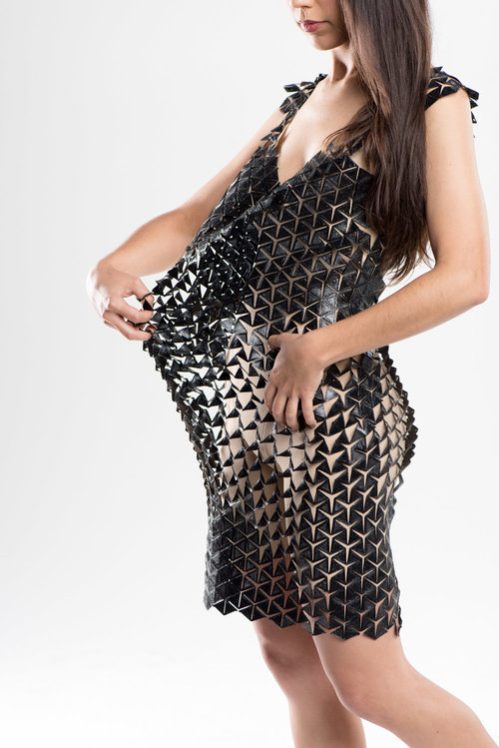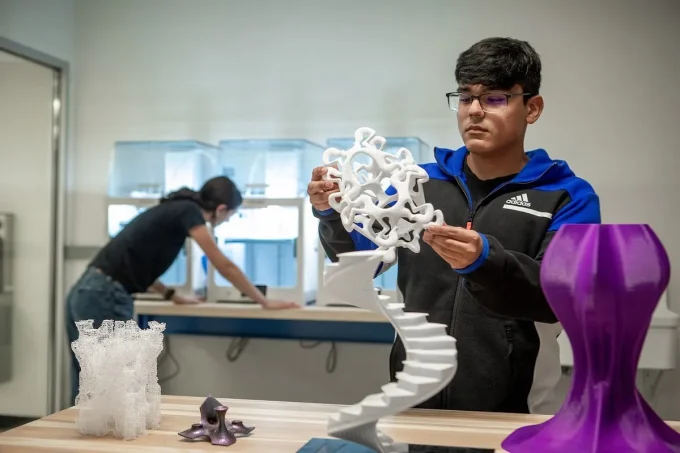Fashion and architecture might seem worlds apart, but they share a similar ethos: both are driven by the pursuit of form, function, and expression. Just as fashion designers sculpt fabric to create wearable art, architects create spaces that cater to our needs. Now more than ever, advanced 3D technologies bridge these two domains and offer a powerful tool bound only by imagination.
3D-Printed Clothes
One of the first 3D-printed clothes in fashion garments to walk the runway was a Crystallization top, credited to Iris Van Herpen in the 2010 Amsterdam Fashion Week. Since then, the limit has been the sky, so this article will cover 10 of the most iconic 3D-printed clothes designs and hopefully tickle your inspiration.
Explore PAACADEMY to master the use of emerging tools in fashion design. It’s your gateway to learning innovative techniques and staying ahead in the ever-evolving world of fashion.
3D Kimono by Ganit Goldstein

In the “WeAreAble” 2020 collection, Ganit Goldstein showcased her Japanese-style dress, combining craftsmanship with direct-to-textile 3D printing. The design adopts the Japanese “ikat” coloring method, as Goldstein spent a year in Japan drawing inspiration from interweaving, craft embroidery, and textile painting.
The kimono follows an algorithm composed of a 3D body scan, which then translates to the surface while printing. This garment marked the first time textiles were leveraged as the skeleton in a 3D printed fashion, which allows extra movement within the fabric. A whole new world and commercial market opens up for comfortable 3D garments using direct-to-textile 3D printing techniques.
Wedding Dress by Iris van Herpen
On May 11, 2024, Mariana Pavani debuted the first-ever 3D-printed wedding dress, designed by the brilliant Iris Van Herpen. It exhumed unearthly elegance, blending high-tech with etherealism. The process of making this dress started with an accurate 3D body scan of Pavani’s figure, followed by over 600 hours of creating the design on Zbrush, a digital sculpting software.
The 3D elements were made from nylon (PA12), and the fabric was very flexible and comfortable to wear. The 3D file was 216.7 MB, and printing the garment took 41 hours! Nonetheless, the bride carried it beautifully, marking a definitive moment in Fashion history.
Rose Petal Gown by Zac Posen
Zac Posen earned his spot in the Met Gala Fashion Legacy back in 2019 with his iconic 3D-printed clothes. The Rose Petal Dress stands out with its bold colors and marvelous form. Using electronic beam melting (EBM), the dress’s frame was printed in titanium onto which 37 petals were layered. These petals were printed in a plastic polymer using an SLA 3D printer and then sprayed with a color-shifting paint finish to give a clear gloss shine.
It was a fruitful collaboration between Posen, Protolabs, and GE Additive that culminated in a 1,100-hour-long printing process and a 30-pound dress. British model Jourdan Dunn carried the dress effortlessly on the Met Gala carpet.
Glass Dress by Zac Posen

Another iconic 3D-printed design belongs to Zac Posen’s 2019 Met Gala carpet. Nina Dobrev wore a glass-like translucent garment that fit her like a glove. It was created using a clear, durable plastic known as Somos Watershed XC 11122 and utilized the use of advanced SLA (stereolithography) technology. It is a method that uses a UV laser to cure liquid resin into solid layers. The entire process took over 200 hours of printing and post-processing, and the end result was a futuristic piece that blended high fashion with high tech.
Dragonfly Wing Bodysuit by Asher Levine

The biomimetic design of this garment, a mix of biology, art, and music, was a collaborative effort between Asher Levine and the generative design studio Nervous System. Grimes debuted Levine’s custom-made bodysuit for her 2022 “Shinigami Eyes” music video. Inspired by the architecture of a dragonfly wing, the design team computationally generated a scale print and customized it with another unique print to obtain the final result.
It was first virtually fitted on a hologram of Grime’s body, then 3D printed. For a final touch, Levine added glowing lights inside to change colors throughout the music video – because why not add drama?
NAMEDRESS by Sylvia Heisel
Among all 3D-printed clothes, this dress stands for more than just an innovative take on fashion; it is also a statement on sustainability and a tribute to women in STEM (Science, Technology, Engineering, and Mathematics). Each name featured on the dress was first digitally handwritten and then converted into 3D models.
The NAMEDRESS is created from WillowFlex, a compostable bioplastic, and then produced by zero-waste 3D printing. Heisel’s portfolio is rich with dresses that make bold statements and leave a long-lasting impression. She combines fashion with function without letting environmental awareness limit her creativity but rather drives it. Also, it’s very wearable and can find customers interested in sentimentally printed garments.
Spider Dress by Anouk Wipprecht
Anouk Wipprecht has definitely earned herself a spot with the most innovative 3D printing fashion designers. Using a selective laser sintering (SLS) process, the dress was printed with nylon powder, a flexible and strong material optimal for wearable technology. This dress also features robotic and sensor technology components, where the robotic arms react according to the data collected from motion and respiration sensors.
If the wearer breathes heavily, the sensors read that she feels threatened, so the robotic arms will respond and extend to defend her. The whole outfit simulates the territorial instincts of a spider; it is indeed iconic and pushes the boundaries of wearable art.
Voltage Collection by Iris Van Herpen and Julia Koerner
The Voltage Collection by Iris Van Herpen, in collaboration with Julia Koerner and Materialise, represents a significant advancement in the fusion of fashion and technology. This dress was produced with Selective Laser Sintering (SLS) using polyamide powder, which facilitated the creation of the intricate lace-like texture and overall haunting allure. What’s captivating about this 3D-printed fashion project is that it looks very wearable and unique at the same time.
Loom by Maria Alejandra Mora Sanchez
In this playful dress, Sanchez wanted to push the limits of 3D printing actual fabrics to create something as comfortable as everyday clothes. Wayuu, a tribe in northern Colombia, inspires the patterns and textiles. In collaboration with Cosine Additive, Sanchez printed her design using thermoplastic polyurethane (TPU), a strong and flexible material, on an FDM printer. The design reaches its flexible potential as it stretches out with a woman’s body change, so even pregnant women can wear it.
Trypophilia Collection by Jasna Rokegem

Jasna Rokegem pioneers an award-winning studio that combines innovative fashion and cutting-edge technology with the physiology of human feelings. For the Trypophilia Collection, Rokegem worked with 3D designer Travis Fitch to visualize the meridians that pass through our bodies and reflect each emotion’s physical location and language.
The primary material used in this process is Vero, a multi-material polymer that allows for the 3D printing of detailed, flexible, and durable structures directly on fabric. Using both Rhino and CLO3D software to translate EQ to 3D algorithmic structures, this collection translates human emotions into wearable garments. With such innovations, you can literally wear your heart on a sleeve.


























Leave a comment